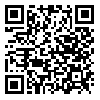BibTeX | RIS | EndNote | Medlars | ProCite | Reference Manager | RefWorks
Send citation to:
URL: http://jdisabilstud.org/article-1-1179-en.html
Abstract
Background & Objectives: Psychological symptoms such as stress, anxiety, and depression are the most common psychiatric disorders that become chronic in most cases. The presence of these symptoms in parents produces undesirable psychological symptoms in their children. These symptoms have a negative impact on individuals' social performance in the future. Positive affects indicate the level of passion and enthusiasm for life and the feeling of effectiveness and alertness of people. On the other hand, negative affects show the general dimension of inner discomfort and unpleasant preoccupation and include unpleasant states, such as hatred, disgust, guilt, fear, and anger. This study aimed to investigate the relationship between positive and negative affects and perceived conflicts of parents with psychological symptoms of junior high school students in Azad Shahr City, Iran.
Methods: This research was a descriptive–correlational study. The study population included all junior high school students of Azadshahr in the academic year 2017–2018 (N= 3540, 2315 boys and 1225 girls). Regarding the size of the statistical population, using the Krejcie and Morgan Table (1970), the sample size was estimated to be 246 people selected by cluster sampling. The study questionnaires were distributed in classes and collected after completion. To collect the study data, the Positive and Negative Affect Schedule (PANAS) (Watson et al., 1988), the Children's Perception of Interparental Conflict Scale (CPIC) (Grych et al., 2004), and the Psychological Symptom Scale (Stress, Anxiety and Depression Scale, DASS–21) (Lovibond & Lovibond, 1995) were used. To analyze the data, we used descriptive statistics, including mean and standard deviation, to classify the data and inferential statistics, including regression analysis, Pearson correlation coefficient, and t test, to compare the variables between two independent groups. All analyses were conducted in SPSS software. The significance level of statistical tests was set at 0.05.
Results: The coefficients of positive affects (p=0.003), negative affects (p<0.001), and perception of parental conflict (p<0.001) were significant in the regression model. The relationship between positive affects and psychological symptoms of students was negative and significant (r=–0.395, p<0.001). The relationship between negative affects and psychological symptoms of students was positive and significant (r=0.456, p<0.001). A positive and significant relationship existed between parents' perceived conflicts and students' psychological symptoms (r=0.410, p<0.001). Also, the difference in mean scores of psychological symptoms (p<0.001), depression (p=0.017), and anxiety (p=0.039) of male and female students was significant.
Conclusion: Based on the findings of this research, conflicts and the intense, pervasive, and exposed hostility between parents have negative effects on their children. In other words, the affective, safe environment of the family, as an essential factor, plays a role in reducing the emotional problems of children in the context of parental conflicts.
| Rights and permissions | |
 |
This work is licensed under a Creative Commons Attribution-NonCommercial 4.0 International License. |





